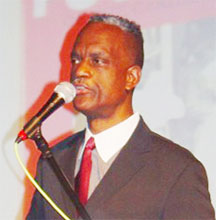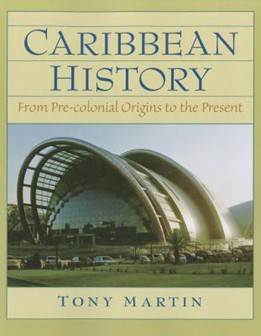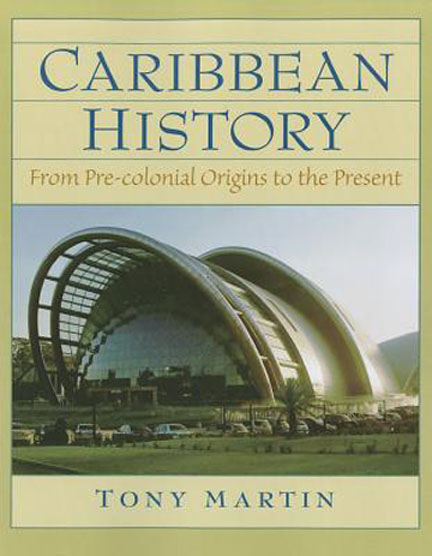Many years ago avid book collector and Emeritus Professor of Africana studies Tony Martin picked up a book by George F Warner cheaply as it was at the end of its print run, but it took him years to discover that the book contained what he now describes as “startling pieces of new information,” one being that the first East Indian immigrant came to the Caribbean in 1595, not 1838.
“This is one of the startling new facts that I have discovered researching this book,” Professor Martin told the Sunday Stabroek in a recent interview.
According to Warner’s book titled The Voyage of Robert Dudley, 1899 and which was reprinted in 1967, the first Indian arrived in Trinidad in February, 1595 in a very unlikely manner, and according to the professor it opens up the possibility of other areas where the experiences are totally unknown. The book reproduced Dudley’s diary of his voyage.

Professor Martin said he doubts that the book is still in print and while he knew nothing about Dudley at the time he is happy that he read every word of his memoirs.
Professor Martin is a Trinidadian by birth, but became a Guyanese citizen recently as a result of marrying a Guyanese from whom he is now separated.
The Indian man, whose name is unknown, arrived in Trinidad before February 17, and it was on this date that he escaped and ran ashore where he remained.
Professor Martin said that the man was one of two Indians who had been captured in India and enslaved by an Englishman somewhere between 1584 and 1586. Many people, he continued, didn’t realise how global the world was 500 years ago, as men were literally sailing around the world. The two Indians were captured by Thomas Cavendish who had them working on his ship, and at some point he either gave or sold them to his friend Sir Robert Dudley, and when the latter visited Trinidad he had the men with him on his ship.
At that time Dudley was looking for El Dorado, and he used Trinidad as a base from which to explore Guyana, which in those days was referred to as the Wild Coast. He sent some of his sailors to Guyana to explore, while he remained on a second ship in Trinidad, and it is during that period that one of the two Indian men escaped, got ashore and was never found again. As a consequence, they were forced to leave without him.

A historian by profession and a barrister also, but one who has never practiced, Professor Martin said the arrival is not significant in so far as the Indian did not start a generation. However, “it is still a very interesting tidbit to know that an Indian actually came here and remained two hundred and forty three years before 1838.”
But he hopes that it is something that other historians may able to research, as he has only opened up the possibility for some other historian to follow. There are so many other projects he would like to write on that the now seventy-year-old professor says he doubts he would be alive long enough to take on another one.
The book
He wrote the book, titled Caribbean History: From Pre-colonial Origins to the Present, after he retired, and refers to it as a culmination of the 34 years of his teaching, research, interaction with students and reflections.
Professor Martin lectured at the Wellesley College in Boston, US for some 34 years, a job he retired from in 2007. Prior to this work, Martin wrote several books, most of which dealt with Marcus Garvey, as his PhD dissertation had been on Garvey.
He said for his entire 34 years of teaching, he was never able to find a survey book on Caribbean history that he was happy with, and his latest work fills the need for what he would call a “proper text book on the Caribbean.”
“I have tried to give it a much more Caribbean focus than any of the others; I have tried to include a lot of information which was never mentioned in other books,” Martin told the Sunday Stabroek.
The book also speaks about the possibility of a variety of people coming to the Americas before Christopher Columbus, such as African Muslims from North Africa, Chinese and Europeans.
“A variety of people may very well have come here, and I deal with Columbus in a way that perhaps other writers have not done,” he said.
He explained that he looked at Columbus not only as the great person he was but also as someone who in a sense began the written history of the Caribbean with an act of genocide. He describes what the Spaniards did to the indigenous people as nothing but genocide.
Professor Martin said that he also dealt with resistance by the Arawaks to the Spaniards, even though he said the history books have displayed them as a peaceful and docile people. But he discovered that despite their docility, they had put up very fierce resistance to the Spaniards.
In terms of survey textbooks Professor Martin said he dealt with African slavery in great detail, and perhaps more detail than anywhere else, and attempted to give some flavour to the horrors of slavery and the punishments that Africans had to deal with. He also spoke about the resistance the Africans put up to slavery which was much more effective than what is generally believed, as they waged a perpetual war against the European enslavers.
Readers would also find information on emancipation and the post-emancipation period, when all kinds of obstacles were thrown in the way of Africans to prevent them from realizing the fruits of freedom.
He said despite all those obstacles, the Africans still made remarkable progress, as within a few decades of the end of slavery there was a whole class of intellectual Africans in the Caribbean. And while most books deal with Indians and the Chinese when speaking about immigration, Professor Martin said he also dealt with the Portuguese, Lebanese and Jews, as well as Africans who came after slavery.
There is also an interesting record of the late President Cheddi Jagan’s appearance before the Face the Nation programme in the United States, as well as a brief discussion of the Walter Rodney saga. Along the way, Professor Martin said he relied on the work of several Guyanese historians, including Walter Rodney, James Rose, David Granger, Tota Mangar, Kimani Nehusi, Winston McGowan and others.
The book became in available in 2012 and while it has been launched in Trinidad the Guyana launch will be on May 21 at the Umana Yana.
From 2008 to now the professor said he has spent most of his time in Guyana, and it was during that time he wrote the book. He said it is doing well in Trinidad and even people who teach history seem to be surprised by the amount of new information it provides. The target audience is undergraduate students, but the professor said the book does have some possibility for the CAPE and CSEC examinations.
“I have tried to write in a non scholarly style… and people who have read it claimed that I have succeeded in making it interesting and non-academic,” he said.
As he wrote his book Professor Martin had an unlikely partner in the form of his five-year-old son, who he said keeps him young and whom he looked after as he wrote. The professor said he had his first child at the age of 64, and he may have “marched to the beat of a different drum” than other men. Right now he is sharing custody with his ex-wife and he is in Guyana every other week so he can spend significant time with his son.
Little Shabaka was with his father every day as he wrote the book, which was typed by then University of Guyana student Tivia Collins.
“I developed the ability, which I never suspected I had, to write serious history and play with my son, talk to him, fix his DVDs, read him stories, bathe and feed him, walk him to sleep, and all the other things that parents need to do for infant children, while simultaneously writing my book in the spaces in between child care,” Professor Martin said.
The two became such familiar figures around the streets of Georgetown that whenever he appears anywhere without him he is greeted with the question, “Where is the little boy?”






